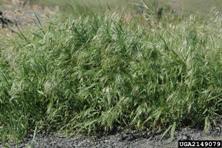AUTHORS
Jennifer K. Balch1,2,5, Marnie K. Carroll3, and Bethany A. Bradley4
1 - National Center for Ecological Analysis & Synthesis, University of California, Santa Barbara, Santa Barbara, CA 93101-3351
2 - The Pennsylvania State University, Department of Geography, University Park, PA 16802
3 - Diné College, Shiprock, NM 87420
4 - University of Massachusetts-Amherst, Amherst, MA, 01003
5 - Corresponding Author: Jennifer Balch (jkbalch@psu.edu)
THE ECOLOGICAL QUESTION
How does cheatgrass (Bromus tectorum) alter fire regimes in the Great Basin?
ECOLOGICAL CONTENT
invasive species, cheatgrass (Bromus tectorum), fire ecology, disturbance, spatial analysis tools
WHAT STUDENTS DO
- Design hypotheses about how an invasive plant species may alter fire behavior.
- Explore NASA’s data archive and download some of the large, publicly available datasets, specifically the MODIS burned area product.
- Perform basic statistics using Excel, including creating linear regression lines, interpreting R-squared values, and conducting t-tests.
- Perform basic spatial processing steps and analysis using ArcGIS, including using zonal statistics and reclassify tools.
- Compare analysis and conclusions from both local field-based data and regional satellite data.
SKILLS
Students will acquire skills in: navigating dataset repositories, manipulating large data sets, reading metadata, creating maps and graphs using GIS (Geographic Information Systems) and statistical tools, and connecting data analysis to scientific concepts.
STUDENT-ACTIVE APPROACHES
Students will be actively engaged through the exercises, which require students to conduct data analysis and answer questions using field-based data and satellite data. The exercises can be done in pairs to facilitate group learning and problem-solving. The module includes a number of short-answer questions designed to help students interpret fire data, as well as an in-class “minute paper,” “think-pair-share” exercise, and a take-home essay at the conclusion of the module. The “minute paper” is an active-learning exercise, which gives students only a couple minutes to write an essay in class, with the intention to generate quick feedback and resolve any confusion. The “think-pair-share” exercise is designed to give students a minute to think on their own, before discussing major concepts or ideas with their nearest neighbor, and then sharing with the whole class. In addition the lab exercises can be split so that two groups can work on separate parts of the problem. If you want to split the exercises for multi-group work Lab 1 can be split into two manageable sets: Part I (questions 1-5); and Part II (questions 6-9). In Lab 2, the first set of questions build through a necessary set of processing steps, but the last few questions are designed to be more open-ended allowing students to explore the data and design their own testable questions. A third lab has been designed for advanced GIS students.
ASSESSABLE OUTCOMES
In addition to the active learning approaches conducted in class, there are several take-home essay questions designed to measure student skills and intended learning outcomes. The following questions can be asked pre- and post- module to determine how much students have learned from the exercises: What controls fire? And how can invasive plant species change fire behavior. In addition, the third advanced GIS lab can be used to gauge student acquisition of the introduced GIS techniques.
TRANSFERABILITY
This teaching module is designed for undergraduates with some introduction to ecology or environmental science. Students should also have some knowledge of GIS and basic statistics, including exposure to descriptive statistics, t-tests, and linear regression. If students have no GIS experience, then the first part of the module can be conducted (i.e., up through the Whisenant data exercise). The exercises require some familiarity with Excel and ArcGIS programs.
SOURCES
- MODIS Burned Area Maps: May-September 2005
- MODIS Burned Area Product (MCD45A1 product):
http://modis-fire.umd.edu/Burned_Area_Products.html
http://modis-fire.umd.edu/BA_getdata.html - Description of MODIS Burned Area Product (Non-technical):
http://modis.gsfc.nasa.gov/data/dataprod/nontech/MOD14.php - Description of MODIS Burned Area Product, Metadata (Technical):
http://modis-fire.umd.edu/BA_usermanual.html - If you wish to download the original, publically-available data: ftp://ba1.geog.umd.edu/
Username: user
Password: burnt_data
Folder: TIFF > Win03 > 2005
-
Save GEOTIFF files:
MCD45monthly.A2005121.Win03.005.burndate.tif (May 2005)
MCD45monthly.A2005152.Win03.005.burndate.tif (June 2005)
MCD45monthly.A2005182.Win03.005.burndate.tif (July 2005)
MCD45monthly.A2005213.Win03.005.burndate.tif (August 2005)
MCD45monthly.A2005244.Win03.005.burndate.tif (September 2005)
Note, these are the raw burned area data for the conterminous U.S. These images have been clipped and processed to be used in this module. See description of datasets in the full-text document for full details on files provided for this module.
DOWNLOADS
- Full Article Text [doc], [pdf]
- Student Data: fire data from Whisenant (1990) [xlsx]
- Faculty Data: fire data from Whisenant (1990) with analysis [xlsx]
- Background information slides [ppt]
- Student handout [docx], [pdf]
- Sample agenda [docx], [pdf]
- R script for analyzing data from Whisenant (1990) [R]
- MODIS burned area product files
- Cheatgrass distribution map [tif]
- State Outlines of Western USA Shape file [zip]
- Vegetation classification of the U.S. Great Basin Shape and Layer files [zip]
Description of Excel Files:
Description of other Resource Files:
ACKNOWLEDGMENTS
The authors would like to acknowledge the efforts of Rick Reeves and Jim Regetz, who provided geospatial processing support. Carla D’Antonio provided substantial insights on the cheatgrass-fire cycle. Leda Kobziar generously provided some slides on fire ecology and invasives for one of the lectures.
CITATION
Jennifer K. Balch, Marnie K. Carroll, and Bethany A. Bradley. May 2012, posting date. The Invasive Grass-Fire Cycle in the U.S. Great Basin Teaching Issues and Experiments in Ecology, Vol. 8: Practice #2 [online]. http://tiee.esa.org/vol/v8/issues/data_sets/balch/abstract.html
